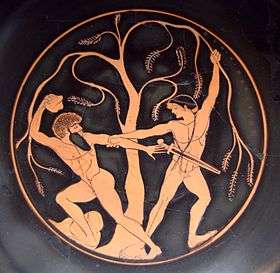Sinis (mythology)

In Greek mythology, Sinis (Σίνις) was a bandit killed by Theseus on the road to Athens.
An Isthmian outlaw, Sinis was the son of Polypemon and Sylea.[1] Sinis would force travelers to help him bend pine trees to the ground and then unexpectedly let go, catapulting the victims through the air. Alternative sources say that he tied people to two pine trees that he bent down to the ground, then let the trees go, tearing his victims apart. This led to him being called Pityocamptes (Πιτυοκάμπτης = "pine-bender").[2]
Sinis was the second bandit to be killed by Theseus as the hero was traveling from Troezen to Athens, in the very same way that he had previously killed his own victims. Theseus then slept with Sinis's daughter, Perigune, who later bore Theseus's son, Melanippus. Perigune later married Deioneus of Oechalia.[3]
According to Pausanias, Sinis's pine was still alive and known during his times.
References
| Wikimedia Commons has media related to Sinis (mythology). |